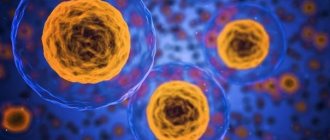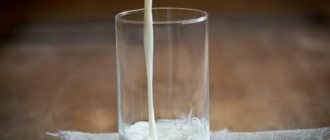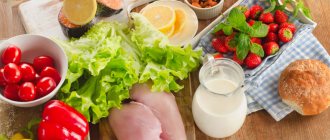Energy balance
The most common mistake is to consider the formula for energy balance in the body as a static “eat less and lose weight.” Anyone who has ever tried to lose weight has encountered the fact that after a certain point it stops losing weight, and additional cuts in calories do not lead to the desired result. One of the possible reasons is inflated expectations when a person strives for an unrealistic weight for his physique.
Our weight, like other vital functions, is controlled by the brain, which receives signals from the outside and from the inside (from the intestines, liver, fatty tissues and muscles). In this way, it regulates calorie expenditure, triggering various processes to optimize body functions. That is why the energy balance formula is very dynamic , and cutting back on your diet does not lead directly to weight loss.
| The less a person eats, the more the body tries to optimize processes and use incoming energy more efficiently. |
As a result of an artificially created lack of energy, many physiological mechanisms are activated, the purpose of which is to optimize the functions of the body in new conditions.
A 2021 study found that appetite and energy expenditure in the brain are regulated by a group of neurons. The processes of burning or saving calories “switch” depending on the current diet.
| The human body easily adapts to gain or lose weight in accordance with external factors and the body's needs. |
Why does weight loss happen?
Essentially, the weight loss process begins with a negative energy balance . This means that during this period the number of calories consumed is less than needed for the daily functions of the body.
The body perceives such a balance as a signal that “hard times” have come, and starts a mode for optimizing energy consumption .
When a person limits the amount of incoming energy in the hope of losing weight, the body does not know that there is, in fact, incredible abundance around and this limited access to food is artificially created - it is programmed to survive.
| Our body knows how to incredibly efficiently distribute available resources to save energy, and when they are abundant, put aside reserves for a “rainy day.” |
Weight Loss Phases
Weight loss involves the loss of fat and lean mass, which is the sum of protein (muscle tissue), glycogen, water, minerals and electrolytes.
Typically, the first phase of weight loss is characterized by relatively large protein losses. First of all, the body consumes proteins contained in the gastrointestinal tract and liver, then in skeletal muscles and, to a lesser extent, in internal organs.
An initially thin person who loses 10 kg of fat risks losing about 15 kg of muscle tissue. With significant obesity, the amount of muscle mass lost decreases. It is important to understand that intense loss of fat-free mass occurs only in the first 4 weeks, that is, in the first phase of weight loss. Once the body reduces the basal metabolic rate to a minimum and enters the second phase of weight loss , fat becomes the main source of energy.
| Basically, the composition of lost body weight is determined by two factors - the initial constitution of a person and the severity of the diet. |
The most common goal when working on the body is the desire to reduce the percentage of fat and maintain or increase muscle mass. To do this, you need to figure out which parameters will help achieve the desired result.
With weight loss and a negative energy balance, the rate of reduction in fat mass will depend on the balance of diet and physical activity.
| An excessively low-calorie diet suppresses the metabolic rate and promotes greater breakdown of protein tissue than a balanced diet and gradual weight loss. |
The process of losing weight is more complicated than “Eat less calories than you burn”!
Everything seems simple, BUT!
Exhaling 8.4 kg of carbon dioxide does not mean losing 10 kg of fat; firstly, there is another 1.6 kg of water that needs to be drained (although I think this can be easily done, but that’s not all).
We eat constantly, that is, food constantly enters our body, passes through complex biochemical processes, and, ultimately, we will most likely exhale our breakfast, lunch or dinner , and not our fat.
To burn fat, you need to launch a complex biochemical process in the body, pull out a fat drop from an adipocyte , a fat cell, I had a separate video about it (link below), then the fat drop must enter the blood , the blood will transfer it to other tissues, for example , liver and muscle cells , where the oxidation of fatty acids will occur , the breakdown product will be water and carbon dioxide , which will enter the lungs through the blood so that we can exhale it. This is very short and without details.
In general, biochemistry is much more complex than simply drawing an arrow and saying that one molecule turns into another. And in fairness, it should also be mentioned that some fat is excreted from the body through the sebaceous glands, some is used as a building material , for example, fats form cell membranes, are the basis of the hormonal system, and are necessary for the functioning of the brain.
Diet composition and weight loss
The composition of the diet plays an important role in the process of losing weight. In addition to the total amount of energy consumed, the physiology of weight loss is influenced by macronutrients, various microelements, and electrolytes.
For example, weight loss on a high-protein diet may be much greater than on a low-calorie, nutrient-balanced diet. However, this difference will be due primarily to differences in water balance, and fat and protein losses will be approximately equal.
Scientists have found that there is an approximate lower limit of calorie intake - 1200 kcal/day . If caloric intake falls below this level, the body can activate physiological defenses against weight loss.
Additionally, fasting as a weight loss technique results in highly disproportionate protein loss. The rate of weight loss during a low-calorie diet and during fasting is almost identical, but the intensity of muscle loss during a low-calorie diet is much lower than during fasting.
| The rate of fat burning with a balanced diet is much greater than with fasting or an extremely low-calorie diet. |
With a low-calorie diet, metabolism quickly adapts - it slows down, which makes such diets not only dangerous, but also ineffective for losing weight. At some point, weight loss decreases, and the body begins to compensate for the lack of energy in other ways.
How?
Before we find out where, let’s find out how fats “disappear” when you lose weight! We already have a great article about this : How to lose weight , but let’s briefly consider this process, because repetition is the mother of learning:
- To begin with, we need a reduced caloric intake in order to generally create a need to replenish energy from our reserves. Those. when you want to eat, but you clenched your will into a fist and endure it, then the body understands: “there is no point in relying on you, you will have to twist yourself!”
- The body then releases the fatty acids from the cells and releases them into the blood. Moreover, it is absolutely unclear where exactly they will be taken from: targeted local fat burning, alas, does not exist!
- After fatty acids enter the blood, they need to be consumed, i.e. any activity that requires calories! Otherwise, they will return back to storage places if the energy demand does not reach certain heights.
An interesting point from the article Cardio or strength training: the best conditions for burning fat. Energy for muscle work : fat is most actively used as a source of energy during low- and medium-intensity cardio (pulse 120-160 beats/min, calm deep breathing). However, in the end, it doesn’t matter at all for weight loss.










